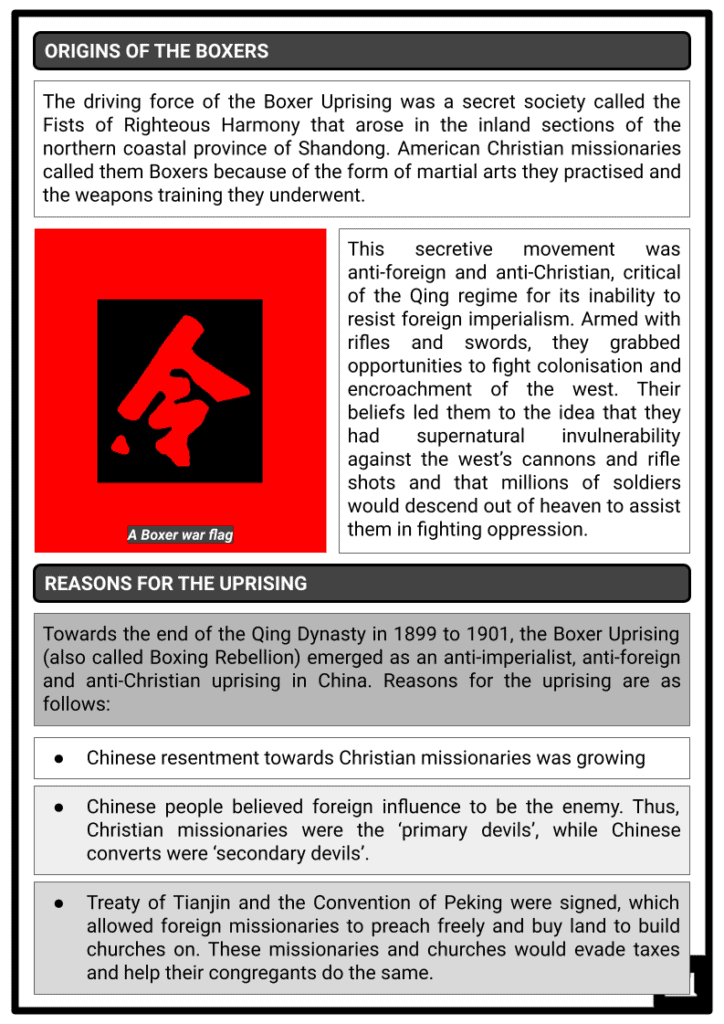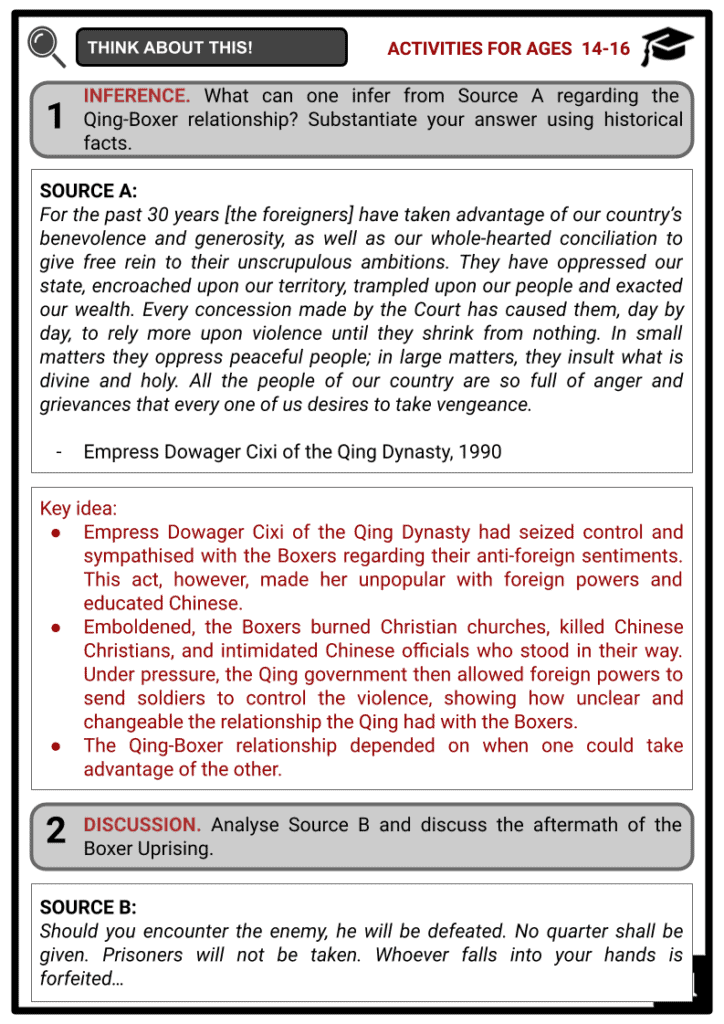Boxer Uprising Worksheets
Do you want to save dozens of hours in time? Get your evenings and weekends back? Be able to teach about Boxer Uprising to your students?
Our worksheet bundle includes a fact file and printable worksheets and student activities. Perfect for both the classroom and homeschooling!
Summary
- Origins of the Boxers
- Reasons for the Uprising
- Trouble in Shandong
- Catholic and Anti-Western Violence
- Qing-Boxer Relationship
- Eight-Nation Alliance
- Boxer Protocol
- Aftermath of the Uprising
Key Facts And Information
Let’s find out more about Boxer Uprising!

The Boxer Uprising, also known as the Boxer Rebellion, was an anti-foreign and anti-Christian uprising in China from 1899 to 1901, towards the end of the Qing Dynasty. It was led by a secret society called the Fists of Righteous Harmony that was composed of XBoxers (as Christian missionaries called them) who practised Chinese martial arts known as Chinese Boxing. It’s believed that as many as 100,000 people were killed in the rebellion.
ORIGINS OF THE BOXERS
- The driving force of the Boxer Uprising was a secret society called the Fists of Righteous Harmony that arose in the inland sections of the northern coastal province of Shandong. American Christian missionaries called them Boxers because of the form of martial arts they practised and the weapons training they underwent.
- This secretive movement was anti-foreign and anti-Christian, critical of the Qing regime for its inability to resist foreign imperialism. Armed with rifles and swords, they grabbed opportunities to fight colonisation and encroachment of the west. Their beliefs led them to the idea that they had supernatural invulnerability against the west’s cannons and rifle shots and that millions of soldiers would descend out of heaven to assist them in fighting oppression.

A Boxer war flag
REASONS FOR THE UPRISING
- Towards the end of the Qing Dynasty in 1899 to 1901, the Boxer Uprising (also called Boxing Rebellion) emerged as an anti-imperialist, anti-foreign and anti-Christian uprising in China. Reasons for the uprising are as follows:
- Chinese resentment towards Christian missionaries was growing
- Chinese people believed foreign influence to be the enemy. Thus, Christian missionaries were the ‘primary devils’, while Chinese converts were ‘secondary devils’.
- Treaty of Tianjin and the Convention of Peking were signed, which allowed foreign missionaries to preach freely and buy land to build churches on. These missionaries and churches would evade taxes and help their congregants do the same.
- Chinese people felt as though their lands and culture were being encroached upon through colonisation.
THE BOXER UPRISING
Trouble in Shandong
- After the German imperialists seized control of Shandong in the 1890s, the Boxer Uprising slowly began to take shape. Tensions rose between foreigners and peasants there.
- Despite Shandong’s terrain being flat and arable, its extreme climate variations caused crops to drown because of floods or dry up because of drought. Thus, it was extremely difficult to store much grain or food, causing economic deprivation, devastating famines, and poverty in the province.
- Nonetheless, the Shandong peasants were known for their strong provincial loyalty and skill and resilience as soldiers. That’s why the Chinese military would actively recruit men from Shandong.
Catholic and Anti-Western Violence
- On 1 November 1897, armed men burst into a Catholic mission in Juye and murdered two German missionaries. Catholic bishop Johann von Anzer advised the German government to send aid, which the latter complied to. Two gunboats were sent to the Shandong coast and German agents went to demand from the Qing government a German sphere of influence in the province.
- As a result of the attacks on German Catholics, the latter were compensated with 3,000 taels of silver as well as fortification of buildings for protection against violent mobs. Moreover, the Germans forced the removal of local officials believed to be responsible for the anti-foreign and anti-Christian sentiment in Shandong.
- Disputes over land and religious sites then grew as a steady flow of German missionaries transferred to Shandong. More protests and violence erupted as Buddhist temples were seized by Christians.
- In October 1899, 1,500 Boxers battled with a smaller contingent of government soldiers at the Senluo Buddhist temple in Pingyuan. The battle debunked the myth that Boxers have magical defences against enemy bullets. Despite this, the Boxer Uprising continued to grow in Shandong and its neighbouring provinces.
- By the end of 1899, gangs of Boxers were attacking and assaulting foreigners and Chinese Christians by burning down buildings constructed or owned by foreigners and by murdering those who owned or carried Bibles and English-language books or items obtained from Europeans. Propaganda against foreigners and Christians was also highly distributed.
Qing-Boxer Relationship
- In late 1899, the Qing appointed Chinese general Yuan Shikai as governor of Shandong. At first, Yuan suppressed Boxer unrest in the west of the province. When both parties recognised the advantages they might provide to each other, attitudes towards the uprising began to shift.

Yuan Shikai - Empress Dowager Cixi of the Qing Dynasty had seized control and sympathised with the Boxers. This made her unpopular with foreign powers and educated Chinese. Emboldened, the Boxers burned Christian churches, killed Chinese Christians, and intimidated Chinese officials who stood in their way. Under pressure, the government then allowed foreign powers to send soldiers to control the violence.
- The carving up of China only increased tensions over imperialism and animosity continued to grow. Meanwhile, the Qing Dynasty was growing weaker over unpopular reforms. By 1900, Chinese culture was under threat.
Eight-Nation Alliance
- Towards the end of 1899, the Boxers were openly attacking Christians and missionaries and bands of boxers had reached Beijing. Foreign powers responded by sending 2,100 men from Tianjin to Beijing. The empress responded by blocking the advance of foreign troops while the Boxers wrecked havoc and killed Christians. Foreign powers escalated on 17 June by seizing the Dagu forts. The empress responded by ordering all foreigners to be killed, and some foreign ministers and their families were murdered.

Qing imperial soldiers during the Boxer Rebellion - This caused an international force of nearly 20,000 mostly Russian and Japanese troops to be assembled. These foreign powers were the so-called Eight-Nation Alliance consisting of Britain, France, Germany, Austria-Hungary, Italy, Russia, Japan and the United States. These imperialist countries with interests in China scrambled to secure their territories and influence in the country.
- Germany - Had exclusive control of development loans, mining, and railway ownership in Shandong
- Japan - Had gained control over Fujian province
- Russia - Had influence of all territory north of the Great Wall of China, tax exemptions for trade in Mongolia and Xinjiang, and economic powers in three other provinces
- Britain - Gained influence over the Yangtze River Valley (this included all provinces adjoining the river), as well as four provinces and part of Tibet
- On 14 August 1900, foreign forces were able to capture Beijing and rescue Christians and foreigners who’d been under siege since 20 June. Foreign troops looted the city and the empress and her court fled to Xi’an in Shaanxi province.
Boxer Protocol
- In September 1901, Qing government representative Li Hongzhang was forced to sign the Boxer Protocol, which was in effect a costly peace treaty for the casualties and damages of the Boxer Uprising.
- The hostilities ended and China had heavy reparations imposed that needed to be paid in full by 1939:
- Pay one silver tael for each head of population equivalent to $US 340 million
- Permanently garrison foreign troops in Beijing
- Ban anti-foreign groups
- Issue a formal apology for the murder of the German ambassador
- Impose military restrictions
- Erect a commemorative arch at the site of the ambassador’s death

Qing forces of Chinese soldiers
Aftermath of the Uprising
- It’s believed that as many as 100,000 people were killed in the Boxer Uprising. In the aftermath, foreign powers dealt directly with the government rather than with the people.
- Beijing, Tianjin and other cities in northern China were occupied by the Eight-Nation Alliance.
- The Americans and British paid General Shikai and his army to kill tens of thousands of suspected boxers in Zhili Province and Shandong.
- Atrocities by foreign troops were common, particularly French troops taking revenge on Boxers on behalf of Chinese Catholics.
- German, Russian and Japanese troops were particularly ruthless and executed Chinese people of all ages and backgrounds, sometimes burning and killing entire village populations
Image Sources
- https://upload.wikimedia.org/wikipedia/commons/1/13/Boxer-tianjing-left.jpeg
- https://upload.wikimedia.org/wikipedia/commons/thumb/9/9d/Yihetuan_flag.png/800px-Yihetuan_flag.png
- https://upload.wikimedia.org/wikipedia/commons/c/c9/Yuan_Shikai_as_governor_of_shandong.jpg
- https://upload.wikimedia.org/wikipedia/commons/8/86/Qing_Imperial_Army.jpg
- https://upload.wikimedia.org/wikipedia/commons/thumb/7/7c/Chinese_soldiers_1899_1901.jpg/1280px-Chinese_soldiers_1899_1901.jpg






